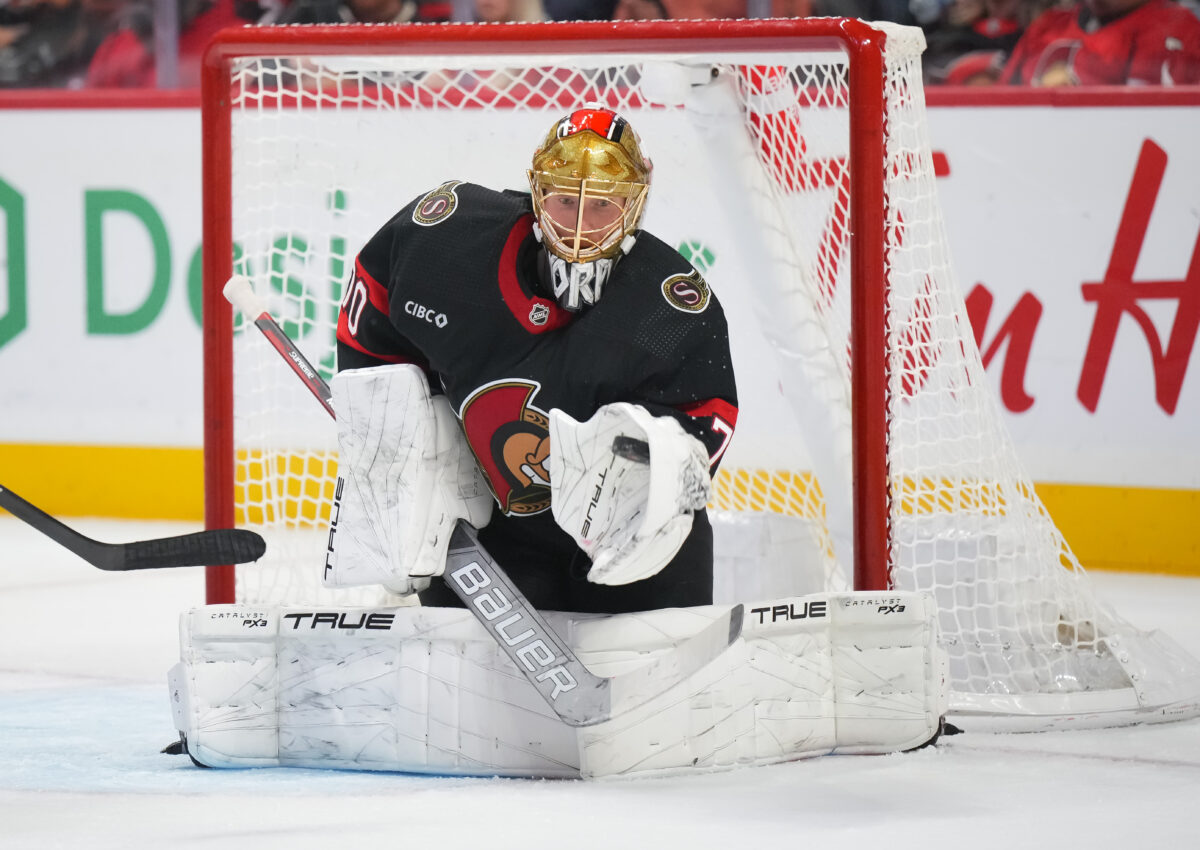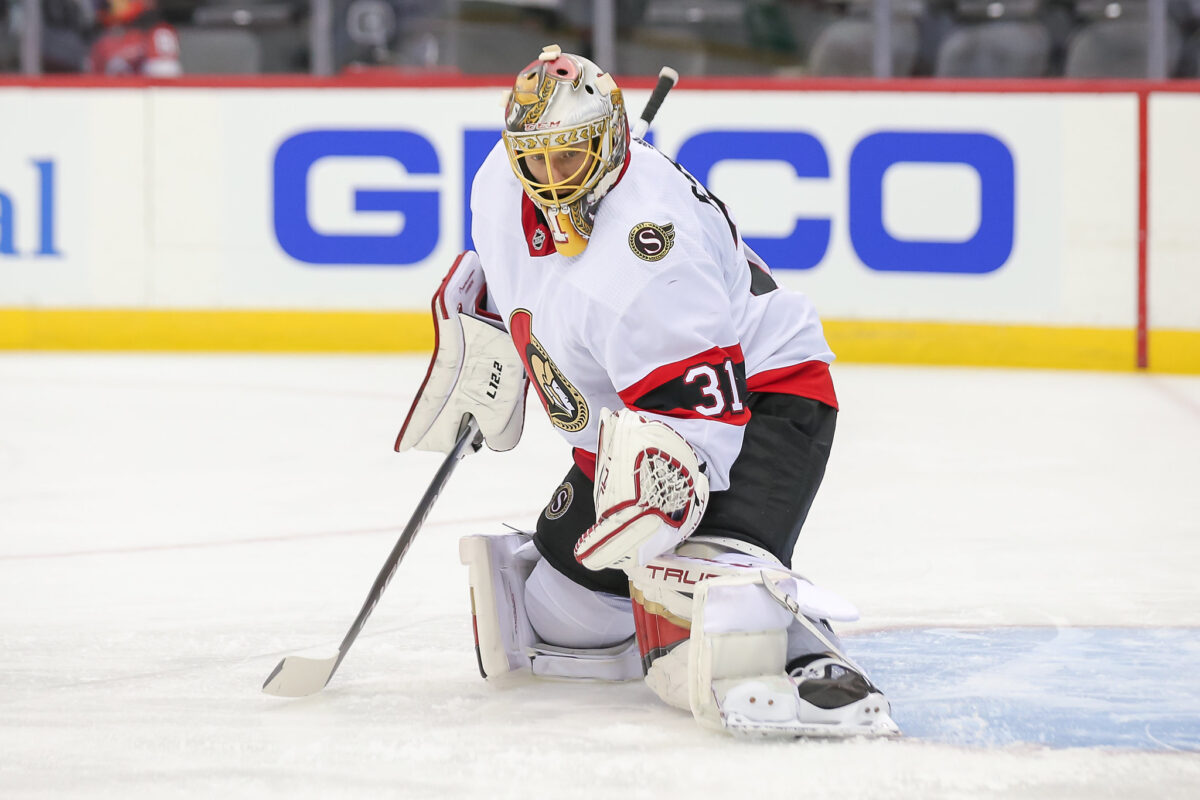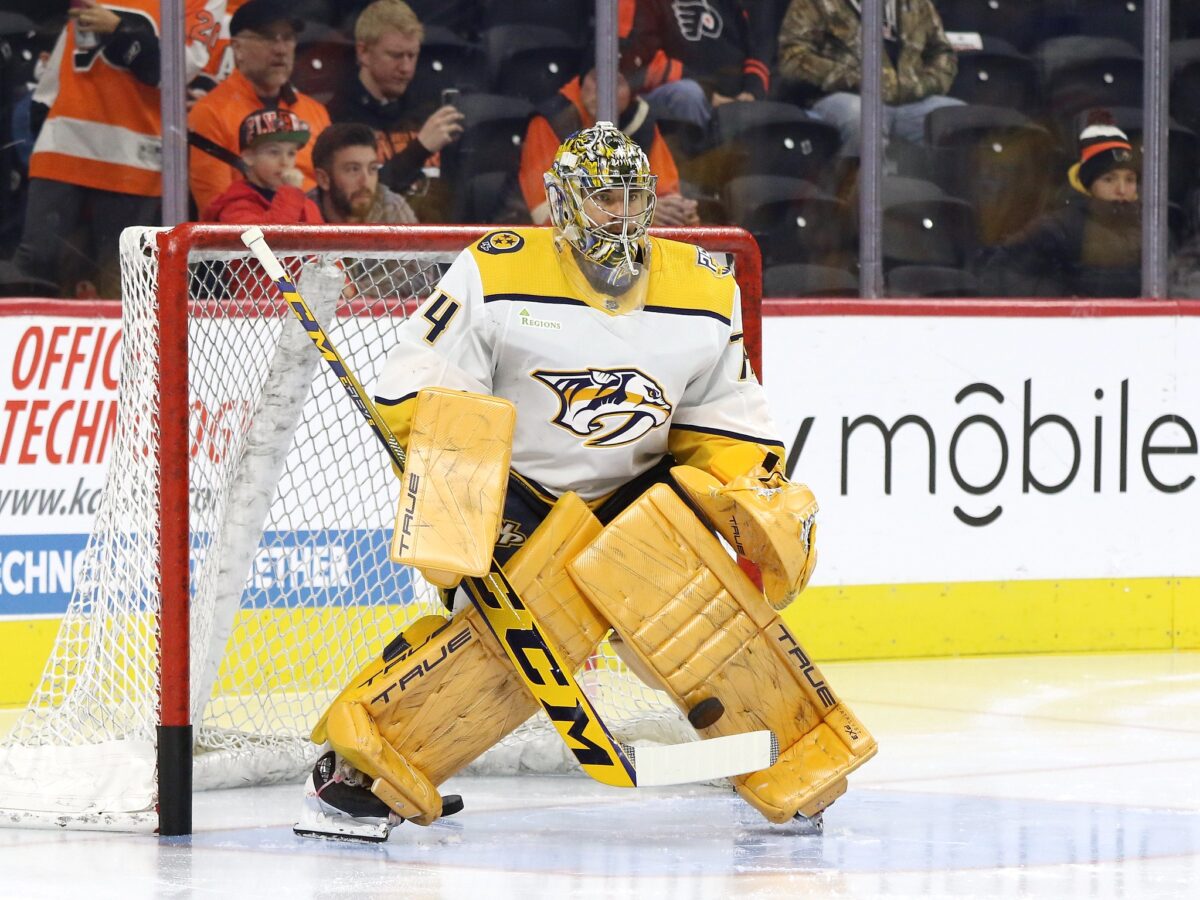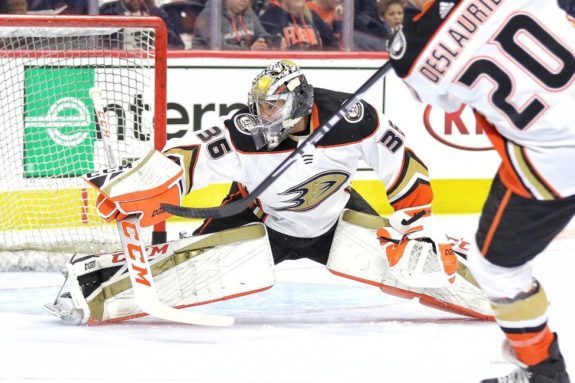Many pundits say Ottawa Senators president of hockey operations and general manager (GM) Steve Staios has serious problems in goal and that he should move quickly to solve them. I say that not only could that be risky, but the team’s netminding is good enough – at least for now. Unless pennies from heaven start raining down on his head, he should stick with the twine minders he has.
And yes, I can hear many readers protesting that the goaltending in Bytown is a raging dumpster fire. To put it out they claim Staios will need the biggest fleet of water bombers ever assembled. Beyond that though, they have nothing more than vague ideas about what it will take to bring Ottawa’s puck stopping up to snuff.
That the Senators’ netminders have put up dreadful numbers so far this season is beyond dispute. Collectively, Joonas Korpisalo, Anton Forsberg and Mads Sogaard have notched a save percentage (SV%) of .881. The league average is .891. They have allowed 170 goals in the 47 games they have played so far this season ranking them 26th among the 32 teams in the league. Allowing an average of 3.62 goals per game makes them almost as bad as the San Jose Sharks – the league’s worst on that metric.

Statistics like these are what make it so easy to argue that Staios must make getting new goaltenders a priority. Still, before making a move, he needs to decide whether he has decent goalies who just look bad because of the team playing in front of them or that they truly are subpar netminders. If the latter, then who does he replace them with knowing that finding top goaltenders is next to impossible in this league?
So, let’s look at whether and when Staios should make a move to improve his team’s performance between pipes. If he wants to act soon, then what options does he have? All of this is to say he needs to be very careful before deciding to make changes in goal.
Do the Senators Really Have a Goaltending Problem?
Does the netminding duo of Korpisalo and Forsberg really explain the team’s last-place standing in the Atlantic Division? For the record, here’s how the two stack up so far this season relative to their career averages on key goalie metrics:
| Goalie | Games Played | 2023-24 SV% | Career SV% | 2023-24 GAA | Career GAA |
| Korpisalo | 33 | .889 | .908 | 3.38 | 3.06 |
| Forsberg | 16 | .889 | .906 | 3.35 | 3.11 |
These numbers could suggest two things. The first is that over the course of their careers, both players have demonstrated an ability to play at a level that makes them respectable anywhere in the league where the average SV% is .904 and average GAA is just shy of three. The second is that they are playing in front of a very weak blue line. Had it been better, goaltending in the nation’s capital would not be a topic of discussion.
Related: Senators Could Regret Joonas Korpisalo Contract
I didn’t set out in this article to evaluate the Senators’ blue line, but it’s beyond dispute that it’s been a disappointment this season. Their play for most of the year has been plagued by embarrassing turnovers (yes you Jakob Chychrun and Artem Zub!) and an inability to exit the D-zone cleanly. Not only that, but they allow opponents to waltz through neutral ice and into their defensive zone unmolested. On the penalty kill they have been awful and helped to put Ottawa at 27th in the league in that category.
With Jake Sanderson’s points production falling off (just two goals and five assists in his last 20 games) and Chabot plagued by injuries, the Senators’ back end hasn’t been much of an offensive threat this season. While Chychrun has put up a decent 28 points in 47 games he has also registered the second-worst plus/minus on the team with a minus-11. He hasn’t been the boon to the Senators’ blue line he was expected to be.
With Forsberg on long-term injured reserve (LTIR) since Jan. 11, the Senators are relying on Korpisalo as their chief crease keeper. What’s telling is that as the Senators have improved of late, so has he. With the team at a respectable 6-2-2 in their last 10 games, Korpisalo has allowed just 10 goals in his last five matches and put up a SV% of .903.

All of this is to make the case that the Senators have decent goaltending – at least in Korpisalo. Given that they are unlikely to be a Stanley Cup contender for a few years, they can afford to make do with what they have.
Staios may want to swing for the proverbial fences (just to borrow a baseball metaphor and apply it to hockey) and acquire a top-10 netminder who could help deliver a Stanley Cup to Ottawa sooner. But those goalies don’t come along very often in this league. As then-Calgary Flames GM Brad Treliving once observed, “I can’t click my heels and make things happen. This isn’t fantasy hockey. The idea that you can go pick ‘this player’ off the player tree … it doesn’t happen that way.”
So, if Staios decides to move ahead and make changes in his team’s goal either leading up to the trade deadline or this summer, what options does he have?
No Easy Way to Improve Senators’ Goaltending
The first challenge for Staios to overcome, assuming he finds a goaltender who could make an impact on his roster, is what to do with one, or both of Korpisalo and Forsberg. Neither is likely to fetch much in a trade now.
Forsberg becomes a UFA at the end of next season and with a contract featuring an average annual value (AAV) of $2.75 million should be relatively easy to move. Yet he is injury prone and potential buyers will be wary of him.
Korpisalo could also be a hard sell on the trade market this summer. His contract runs four more years and has an AAV of $4 million – very dear given his performance. Added to that, his contract has a modified no-trade clause that allows him to name 10 teams he won’t play for. Given his play in Ottawa up to this point in the season, there won’t be a lineup of NHL GMs interested in his services.
Still, if he can begin to put up better numbers consistently as he seems to be doing now, he may fetch a decent return. Yet if he were doing that, then why would Staios want to move him? Even if he could find a top-10 goalie, why not keep Korpisalo as a backup while prospects like Sogaard mature in Belleville?
The most obvious place to look for better goaltending is on the free agency market this summer. Staios may also want to kick the tires on a few goalies with a year or two left on their contracts. Their teams may be open to an exchange with Ottawa if they have doubts about their ability to re-sign them for the long-term. Or perhaps don’t need to.
Let’s look at a few intriguing options for a new goaltender that Staios might consider. Keep in mind that others could have been added to the list and all of them are a swing for the fences.
Jusse Saros – Nashville Predators
“Juice” as Saros is known by his nickname, has been the starting goaltender with the Nashville Predators since the 2021-22 season. The 28-year-old Finn’s contract carries an AAV of $5 million per year and has a year left to run after this season.
Last season he was in the running for the Vezina Trophy, appeared in the All-Star Game and recorded a SV% of .919 and a GAA of 2.68. His struggles earlier this season may lower his trade value, as will the fact that he only has one year left on his contract.

Saros has a reasonable price tag and he’s rated among the top-25 goalies in the NHL based on his SV% and GAA. But what has no doubt grabbed the attention of Staios is that there have been rumours the Predators are listening to offers for him as the trade deadline approaches.
It’s unlikely he would be a trade deadline purchase since the Predators are in contention for a wild card entry into the playoffs. So off-season discussions between Staios and Predators’ GM Barry Trotz would be the most likely scenario if the Senators chose to pursue him.
Jeremy Swayman – Boston Bruins
Jeremy Swayman along with his partner Linus Ullmark won the William M. Jennings Trophy last spring as goaltenders for the team with the fewest goals against. His contribution to the trophy win was a SV% of .920 and a GAA of 2.27.
The 25-year-old Alaskan, known in the dressing room as “Sway”, becomes a restricted free agent (RFA) at the end of this season when his contract featuring an AAV of $3.475 million expires. Many question why the Bruins would let Swayman leave Beantown since he and Ullmark combine to give the Bruins one of the most talented goalie duos in the league. And God only knows how many extra tickets the Bruins sell because of their famous goalie hug when they celebrate wins!
The answer is simple – he’s surplus to the Bruins’ needs. With goaltending talent in short supply across the league, Bruins GM Don Sweeney knows Swayman could bring him additional depth at forward and even a few picks and prospects to replenish his team’s meagre talent pipeline. Also fueling speculation that Swayman could be moved is that as of Jan. 1, he was eligible to sign a contract extension and that hasn’t happened yet.
John Gibson – Anaheim Ducks
Anaheim Ducks goaltender John Gibson is often mentioned as a trade chip. With the Ducks still rebuilding, the 30-year-old Pittsburgh native would fetch a handsome return.
Gibson would be an expensive addition to the Senators roster with his contract carrying an AAV of $6.4 million. The Senators would face difficulty finding the cap space to sign him. Not only that, but he has a 10-team no-trade list and Ottawa could very well be one of the cities where he won’t play. On the plus side, his deal runs for the next three seasons providing stability to the Senators’ goal.

Gibson has struggled this season with a GAA of 3.05 and a SV% of .901 making him perfectly average by NHL standards. Even so, it’s important to remember when sizing him up for a trade that over his 463-game NHL career thus far, he has notched an impressive GAA of 2.84 and SV% of .912.
Slim Pickings for Ottawa on the NHL Goalie Market
Acquiring Saros, Swayman or Gibson would be a coup for Staios. But the prospects of adding them or other trade targets of the same calibre are slim.
That leaves the Senators to contemplate the likes of Ukko-Pekka Luukkonen of the Buffalo Sabres or Vitek Vanecek of the New Jersey Devils. Yet would any of these trade targets be a marked improvement over what the Senators already have? As discussed on this week’s episode of The Hockey Writers’ Senators Roundtable (see goaltending discussion at 41:29), the answer is probably not.
No Easy Way for Staios to Improve Senators’ Goal
Goaltenders are the foundation of any good NHL team. If a GM has one, his team can go a long way with mediocre talent as the Montreal Canadiens did in 2021 when Carey Price took them to the Stanley Cup Final. Without it, even the most talented teams can flounder. Just ask the Edmonton Oilers before they got rid of Jack Campbell earlier this season.
Even so, top-end goalies have been scarce in the NHL for years and teams are loathe to give them up. That’s why most of them are drafted and developed rather than picked up in trades or free agency. Not only that, but seemingly mediocre goalies can flourish with the right team in front of them.
All of this is to say Staios needs to be careful in deciding when and even if, at least for now, he needs to make changes in his net.
